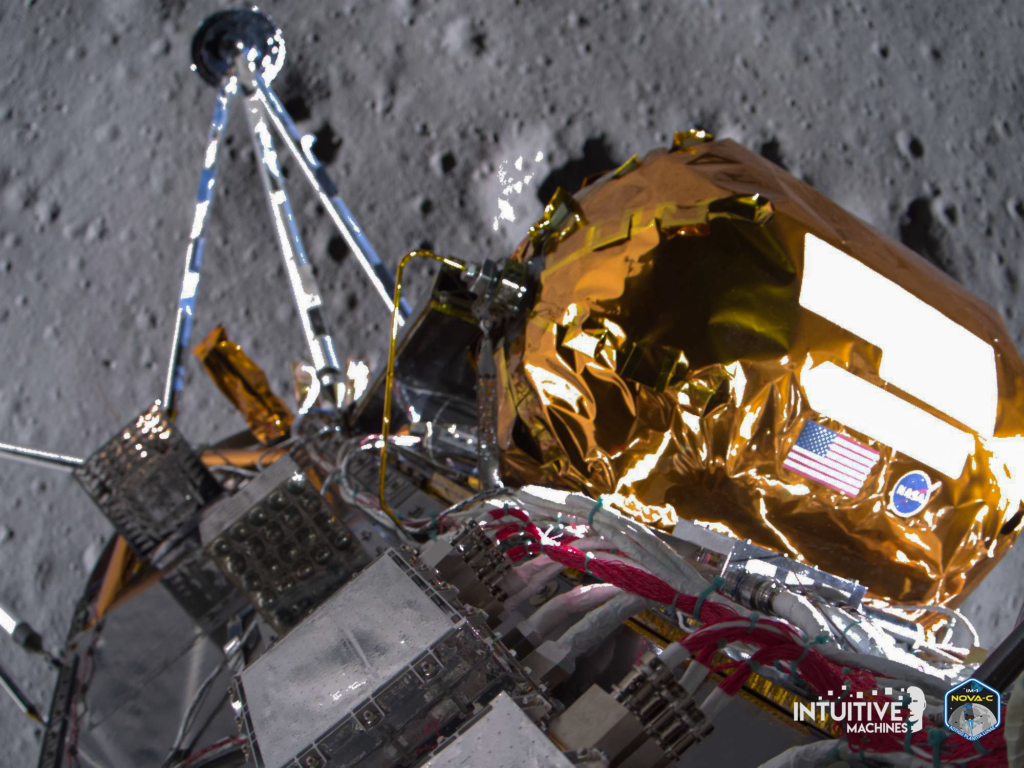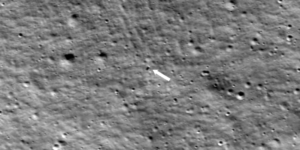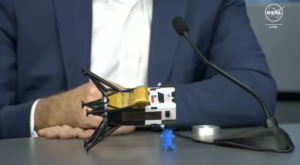
The Odysseus Moon Lander Is Officially Out of Power
After just about a week on the Moon’s surface, the Odysseus lander is officially out of power as the long lunar night begins. In the last few days, we received even more images showcasing its position on the surface, broken landing legs, and tilt. This comes in addition to another press conference revealing what payloads were affected and the state of the lander.
While it’s possible that Odysseus survives the lunar night, teams at Intuitive Machines didn’t design the lander to do so which means the mission has likely come to an end. Here I will go more in-depth into the new images, the lander’s power, final operations, and more.
More New Images

The Odysseus lander made contact with the Moon on February 22nd. The first time that IM released images it was hard to make out practically any detail as the quality was not very good either from onboard cameras or from the Lunar Reconsicenss Orbiter. Thankfully some of the new images paint a better picture of what exactly happened and the state of the lander. For example, one image from an onboard camera shows the lander right as it makes contact with the Moon. The company was quoted saying, “This image illustrates Odysseus’ landing strut performing its primary task, absorbing first contact with the lunar surface to preserve mission integrity. Meanwhile, the lander’s liquid methane and liquid oxygen engine is still throttling, which provided stability. The Company believes the two insights from this image enabled Odysseus to gently lean into the lunar surface, preserving the ability to return scientific data” they said.
Taking a closer look you can see one of the 6 landing legs has broken from impact. This suggests that the lander didn’t necessarily just tip over but had a harder impact than expected. The combination of higher speeds both going down and sideways was too much for the lander to stay upright and fully intact.
Another image highlights the actual tilt or lean of the lander on the surface. Here you can see one of its landing legs up in the air with the lander on its side. In relation to this image, the company said, “Taken on February 27th, flight controllers commanded Odysseus to capture a new image using its narrow-field-of-view camera. Previous attempts to send photos from landing and the days following returned unusable imagery. After successfully transmitting the image to Earth, flight controllers received additional insight into Odysseus’ position on the lunar surface” they said.
Despite some of the errors that occurred, Intuitive Machines has expressed that they are very happy with how the mission went. In a quote they pointed out, “The IM-1 Mission successfully landed the first spacecraft on the Moon’s south pole region, marking the United States’ first return since Apollo 17 and the first commercial lunar lander to transmit valuable science data of each NASA payload from the lunar surface. In addition, the operation of the Company’s liquid methane and liquid oxygen propulsion system in deep space is flight-proven through successful mission operations. Intuitive Machines achieved these accomplishments in the Company’s first attempt to land on the Moon” they said.
To add to this, the CEO of Intuitive Machines said, “We had some very high level mission objectives to touch down softly on the surface of the moon — softly and safely — and return scientific data to our customers. Both of those objectives are met, so in our minds this is an unqualified success” he said.
When Odysseus was originally preparing to land, teams discovered that laser rangefinders on the spacecraft were inoperable, and instead modified software to use lasers on a NASA payload, the Navigation Doppler Lidar. This change was enough to get the lander on the surface but not at the speeds and exact destination IM and NASA had originally planned. In fact, the slope of the landing site is relatively steep at around 12 degrees. This likely impacted Odysseus’s landing attempt adding to the sideways movement and increasing the chances of the lander tipping.
Besides new images, we also learned that the lander is now out of power, and is not technically designed to ever wake up again.
Out of Power

A few hours ago the company tweeted saying, “Still kicking, Odysseus continues to operate on the lunar surface. At approximately 1100 CST flight controllers intend to downlink additional data and command Odie into a configuration that he may phone home if and when he wakes up when the sun rises again.” In other words, with the lunar night now here, the system is going into hibernation mode as it no longer has the power to consistently communicate with Earth. If in a few weeks when the sun rises and it gains some charge, it will attempt to send a signal.
Yesterday on the 28th, NASA and Intuitive Machines held a second press conference to go over what exactly happened. The first was mainly about the state of the lander and how they believed it tipped over. At the time they didn’t know a lot about what payloads would be affected and if the mission would continue on. This time, however, the company had a much better idea.
We learned that after the lander had made contact, it took the company some time to determine its exact orientation. This was important as it determines the direction certain antenna and solar panels are pointing for communication and power. At the press conference, they confirmed that not only was the lander on its side at around a 30-degree angle, but it had also rolled slightly which added to the complications in determining its exact state.
They did however manage to get the solar panels in the right orientation and begin gathering energy. That being said, the lunar night has begun. The IM CEO was quoted saying, “We know we are degrading in power, and we expect that within about 5 hours or so from now is when we will be at a point where we will no longer have commanding or telemetry coming down.” That was said during the livestream just over 24 hours ago. At this point, it seems that the team has finally put Odysseus to sleep with the hope that in a few weeks, once the lunar night has passed, they can wake up the lander. As far as its mission lasting around 7 days, they highlighted that this was the goal and the plan was not to have the lander last for a very long time.
Even still, once the sun hits the solar panels again they will try to wake up the lander. When asked about the chances of surviving the night, they said, “The number 1 limiter we face is the batteries. Batteries are a chemical asset and that chemistry does not respond well to deep cold. So if something happens to the batteries for 14 days of less than 250 degrees then we won’t be able to come back up. And the batteries are absolutely not tested to that level of cold, neither are our flight computers or radios. If we asked our vendors to tell us what the probability was of surviving the deep cold of the Moon they would not put it in writing.”
He went on to say, “Our solar arrays should handle that fine. We’re confident that when the sun comes back up over Odysseus that the solar arrays will energize and send power. The real question is are the batteries there to receive that power and pass it on, and then will the electronics within our computer and radio have withstood that deep cold and not cracked under the thermal stress” he said. With all this in mind, we shouldn’t expect to hear much from the lander or IM over the next few weeks.
Focusing on the payloads, it seems that most of them ended up successfully receiving and transmitting valuable data. They said that they have gotten data from all 12 payloads, both the 6 commercial and the 6 NASA experiments. Specifically, they were quoted saying, “What we’ve gotten in terms of data on the vehicle is a tremendous amount of the guidance navigation and control data, all the propulsion data, and the performance data on the vehicle that will allow us to completely reconstruct the mission,” he said. Although, they did point out one payload that hasn’t quite worked as originally intended.
One of the commercial payloads that may have failed is EagleCam, an instrument that was designed to deploy from Odysseus about 100 feet (30 meters) above the lunar surface and photograph the craft’s touchdown from below. Unfortunately, they decided to power down EagleCam during landing and not deploy the device because of a necessary software patch related to navigation complications. It was revealed that EagleCam was finally deployed early Feb. 28, landing about four meters away. Even still, the IM CEO said, “Either in the camera or in the wi-fi signal back to the lander, something might not be working correctly,” The project team at Embry-Riddle Aeronautical University was working on the issue, although before the launch that project team said EagleCam had a battery life of only about 30 minutes, limiting any ability to correct problems. It seems at this point that the camera will likely not send or receive any data.
A full lunar day is 28.3 Earth days long, with around 14 Earth days of sunlight, and close to 14 Earth days of darkness. Since the lander touched down on the Moon at what could be called the lunar noon-time, approximately seven Earth days after the lunar sunrise for that lunar day, the lander only had approximately 7 remaining Earth days of sunlight left before the next lunar sunset. The lander made contact on the 22nd meaning the night has begun. Accordingly, the Odysseus system has been programmed so that after seven days, once the sun has finally set over the landing site, it will fully and finally shut down. There is a chance of it waking up toward the middle of March but the lander wasn’t technically designed to do that. Teams will still try as they might as well.
Either way, Intuitive Machines will use all the information gained to improve on their next missions. As of right now, there are two more IM missions scheduled to happen later this year and likely in early 2025. Named IM-2 and IM-3, the company is hoping for a fully successful landing and even better results.
Conclusion
With the lunar night now beginning, Odysseus is asleep and might not ever wake up. The company will try in a few weeks but the brutal conditions of the Moon could keep it in a out of battery state. We will have to wait and see how it progresses and the impact it has on the space industry.



